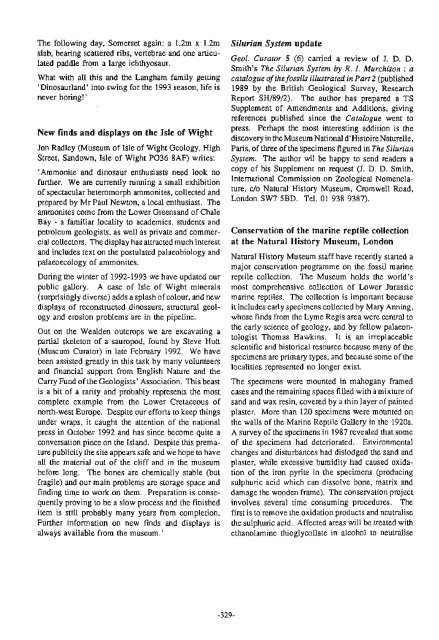Number 8 - Geological Curators Group
Number 8 - Geological Curators Group
Number 8 - Geological Curators Group
- No tags were found...
You also want an ePaper? Increase the reach of your titles
YUMPU automatically turns print PDFs into web optimized ePapers that Google loves.
The following day, Somerset again: a 1.2m X 1.2mslab, bearing scattered ribs, vertebrae and one articulatedpaddle from a large ichthyosaur.What with all this and the Langham family getting'Dinosaurland' into swing for the 1993 season, life isnever boring! 'New finds and displays on the Isle of WightJon Radley (Museum of Isle of Wight Geology, HighStreet, Sandown, Isle of Wight P036 8AF) writes:'Ammonite and dinosaur enthusiasts need look nofurther. We are currently running a small exhibitionof spectacular heteromorph ammonites, collected andprepared by Mr Paul Newton, a local enthusiast. Theammonites come from the Lower Greensand of ChaleBay - a familiar locality to academics, students andpetroleum geologists, as well as private and commercialcollectors. The display has attracted much interestand includes text on the postulated palaeobiology andpalaeoecology of ammonites.During the winter of 1992-1993 we have updated ourpublic gallcry. A case of Isle of Wight minerals(surprisingly diverse) adds a splash of colour, and newdisplays of reconstructed dinosaurs, structural geologyand erosion problems are in the pipeline.Out on the Wealden outcrops we are excavating apartial skclcton of a sauropod, found by Steve Hutt(Muscum Curator) in latc February 1992. We havebeen assisted greatly in this task by many volunteersand financial support from English Nature and theCurry Fund of the Geologists' Association. This beastis a bit of a rarity and probably represents the mostcomplete example from the Lower Cretaceous ofnorth-west Europe. Despite our efforts to keep thingsunder wraps, it caught the attention of the nationalpress in October 1992 and has since become quite aconversation piece on the Island. Despite this prematurepublicitythe site appears safe and we hope to haveaU the material out of the cliff and in the museumbefore long. The bones are chemically stable (butfragile) and our main problcms arc storage space andfinding time to work on them. Preparation is consequentlyproving to be a slow process and the finisheditem is still probably many years from completion.Further information on new finds and displays isalways available from the museum.'Silurian System updateGeol. Curator 5 (6) canied a review of J. D. D.Smith's The Silurian System by R. I. Murchison : acatalogue of the fossils illustrated in Part2 (published1989 by the British <strong>Geological</strong> Survey, ResearchReport SH/89/2). The author has prepared a TSSupplement of Amendments and Additions, givingreferences published since the Catalogue went topress. Perhaps the most interesting addition is thediscoveryintheMuseumNationa1 d'HistoireNaturelle,Paris, of three of the specimens figured in The SilurianSystem. The author wil be happy to send readers acopy of his Supplement on request (J. D. D. Smith,International Commission on Zoological Nomenclature,c/o Natural History Museum, Cromwell Road,London SW7 5BD. Tel. 01 938 9387).Conservation of the marine reptile collectionat the Natural History Museum, LondonNatural History Museum staff have recently started amajor conservation programme on the fossil marinereptile collection. The Museum holds the world'smost comprehensive collection of Lower Jurassicmarine reptiles. The collection is important becauseit includes early specimens collected by Mary Anning,whose finds from the Lyme Regis area were central tothe early science of gcology, and by fellow palaeontologistThomas Hawkins. It is an irreplaceablescientific and historical resource because many of thespecimens are primary types, and because some of thelocalities represented no longer exist.The specimens were mounted in mahogany framedcases and the remaining spaces filled with a mixture ofsand and wax resin, covered by a thin layer of paintedplaster. More than 120 specimens were mounted onthe walls of the Marine Reptile Gallery in the 1920s.A survey of the specimens in 1987 revealed that someof the specimens had deteriorated. Environmentalchanges and disturbances had dislodged the sand andplaster, while excessive humidity had caused oxidationof the iron pyrite in the specimens (producingsulphuric acid which can dissolve bone, matrix anddamage the wooden frame). The conservation projectinvolves several time consuming procedures. Thefirst is to remove the oxidation products and neutralisethe sulphuric acid. Affected areas will he treated withethanolamine thioglycollate in alcohol to neutralise
















